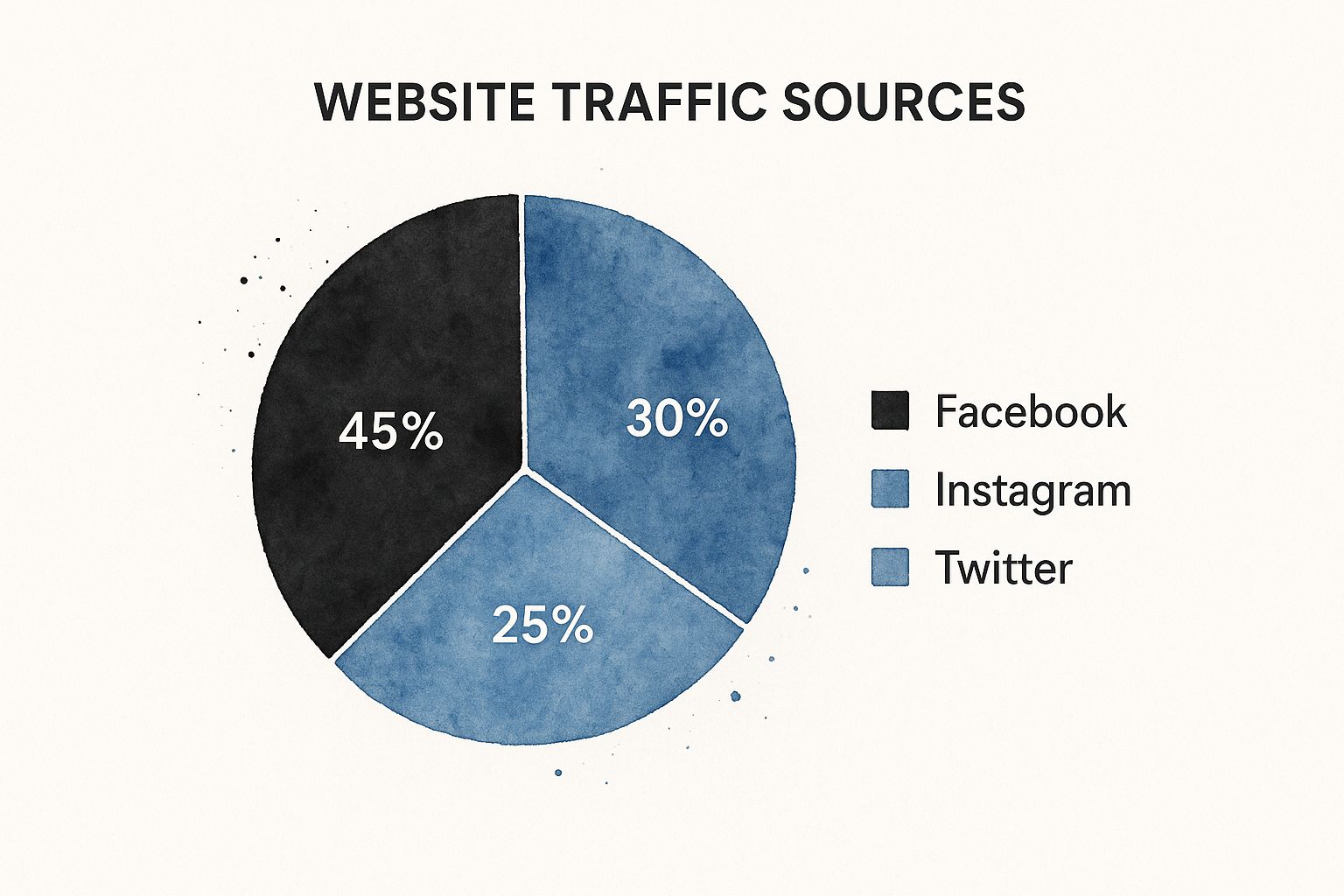Driving traffic to your website really boils down to three things: building a rock-solid technical foundation, creating killer content people are actually looking for, and then promoting that content like crazy. If you can get these three areas right, you'll have a sustainable system for bringing visitors to your digital doorstep.
Building a Website That Earns Traffic

Before we even think about how to generate traffic, we need to have a destination worth visiting. Your website is your digital storefront. If it's messy, slow, or confusing, people will just leave. It's the same online—both users and search engines reward great experiences.
Your first move is to lock down a strong technical foundation. This goes way beyond looks; it's the core structure that tells search engines how to crawl your site and shapes how users interact with it. A clunky, disorganized site actively pushes traffic away by making it tough for Google to understand your content and for visitors to find what they need.
Prioritize Technical Health and User Experience
So many site owners get excited and jump straight into creating content without ever checking their site's health. This is a huge mistake. Slow page speed is probably the biggest killer of traffic—if your pages take more than three seconds to load, you're losing a huge chunk of your audience before they even see what you have to offer.
Here’s a quick-and-dirty checklist to get you started:
- Mobile-First Design: Your website absolutely must be responsive. With most traffic now coming from mobile devices, a bad mobile experience is a non-starter.
- Page Speed: Use a tool like Google's PageSpeed Insights to see where you stand. Simple fixes like compressing your images and cleaning up your code can make a massive difference.
- Clear Navigation: Your menu needs to be simple and logical. A new visitor should be able to figure out what you do and find important pages in just a few seconds.
A website's foundation is built on user trust. If a visitor can't easily navigate your site or has to wait for pages to load, that trust erodes instantly, and so does your potential traffic.
Essential Tools for Tracking Success
Setting up the right analytics tools from day one is non-negotiable. Seriously. Google Analytics and Google Search Console are the two most critical platforms for understanding your traffic. They're completely free and give you priceless data on who your visitors are, how they found you, and what content they actually care about.
If you're serious about building a strong online presence, this guide on membership community platform success offers some great insights into creating a site that doesn't just attract an audience but keeps them coming back. Nailing these foundational steps ensures that when you do start driving traffic, your site is actually ready to convert those visitors into loyal fans or customers.
Creating Content That Attracts Your Ideal Audience

Great content is the engine of any traffic strategy, but that engine won't do you much good if there's no fuel in the tank. The whole "if you build it, they will come" idea is a myth. It just doesn't work that way. To get real, sustainable traffic to your website, you have to create content that shows up when your ideal audience types a question into Google.
This whole process starts way before you write a single word. It begins with truly understanding the problems, questions, and pain points of your target customer. Your mission is to become the most helpful, go-to resource they can find online.
Uncovering What Your Audience Really Wants
Let's get one thing straight: effective keyword research isn't about stuffing phrases into your articles. It’s about empathy. It's about figuring out the exact language your audience uses when they're searching for answers. Think about their entire journey—what's the first question they ask? What about the follow-up questions that come next?
For example, a broad keyword like "marketing" is practically useless. But something super-specific like "how to market a new local coffee shop" is gold. That query attracts a highly qualified visitor who has a specific, urgent need you can solve. They aren't just browsing; they're looking for a solution.
Your best content ideas will come directly from the questions your customers are already asking. Spend time lurking in forums, social media groups, and even your own customer support tickets to find the exact phrasing they use.
Once you have a list of these valuable, intent-driven keywords, you can start building content that provides a clear, comprehensive answer. This is how you build a traffic engine that works for you around the clock.
Mastering On-Page SEO for Visibility
With your topic locked in, the next step is optimizing the content so search engines can actually understand it and rank it. This is where on-page SEO comes into play. It’s really just the art of sending clear signals to Google about what your page is about.
Here are the crucial elements you need to nail:
- Compelling Title Tags: Your title is your first (and maybe only) impression on a search results page. It absolutely must include your primary keyword and be interesting enough to earn a click. A title like "10 Practical Ways to Market Your New Coffee Shop" is way more effective than a generic "Coffee Shop Marketing."
- Intriguing Meta Descriptions: Think of this as a tiny ad for your article. While it doesn't directly impact rankings, a well-written description that summarizes the value inside can dramatically boost your click-through rate.
- Logical Heading Structure: Use headings (H1, H2, H3) to break your content into logical, scannable sections. This not only helps readers quickly find what they need but also gives search engines a clear outline of your content's structure.
The consistency of your publishing schedule also plays a massive role here. Some research shows that publishing 16 blog posts per month can lead to 3.5 times more traffic than publishing four or fewer. And with over 70% of internet users preferring to learn about a company through blog posts rather than ads, a steady stream of valuable content is non-negotiable.
For more in-depth guides and inspiration, feel free to check out the growth-focused articles on the RebelGrowth blog.
Promoting Your Content for Immediate Traffic
Creating amazing content is half the battle. The other half? Making sure people actually see it.
Hitting "publish" and hoping for the best isn't a strategy. If you really want to generate traffic, you have to get out there and actively promote your work across the channels where your ideal audience already hangs out.
This means moving beyond just SEO and building a promotion engine that drives immediate, targeted visitors. The goal isn't to be everywhere at once, but to be in the right places, consistently.
Choose Your Social Media Platforms Wisely
One of the biggest mistakes I see businesses make is trying to maintain a presence on every single social media platform. This approach just stretches your resources thin and usually leads to mediocre results across the board.
Instead, pour your energy into the one or two platforms where your target audience is most active and engaged.
Think about it: for a B2B software company, LinkedIn is a goldmine for connecting with decision-makers. But a direct-to-consumer brand selling something visual, like handmade jewelry, is going to find a much more receptive audience on Instagram or Pinterest.
This chart really drives home how different platforms can contribute to website traffic, and it highlights the dominance of a few key players.

While the data suggests focusing on giants like Facebook can yield huge returns, your specific audience’s behavior should always be your North Star.
Leverage Email Marketing for Repeat Visitors
Your email list is one of the most valuable assets you own. Period.
Unlike social media followers, who are at the mercy of ever-changing algorithms, your email subscribers have explicitly given you permission to pop into their inbox. This is your owned audience.
Building this list is non-negotiable. A great way to start is by offering a valuable resource—maybe a checklist, a template, or an exclusive guide—in exchange for an email address. Placing these offers within relevant blog posts or on dedicated high-converting landing pages is a super effective way to rack up sign-ups.
Your email list is full of your most loyal readers. Nurture that relationship. Send them your best content first. This simple act builds a ton of goodwill and can turn subscribers into advocates who will gladly share your work.
Dip Your Toes into Paid Advertising
While organic methods are the bedrock of long-term growth, paid advertising is your shortcut to immediate, predictable traffic. And you don't need a massive budget to get started.
Even small, highly focused campaigns on platforms like Google Ads or Facebook can bring in valuable data and attract high-intent visitors—fast.
For instance, you could run a small Google Ads campaign targeting a very specific, long-tail keyword related to your core product. This lets you test your messaging and landing page effectiveness without a huge financial commitment. It's a low-risk way to learn what works.
Comparing Key Traffic Generation Channels
To help you visualize where to focus your efforts, let's break down the most common channels. Each has its strengths and plays a unique role in a well-rounded strategy.
| Channel | Average Traffic Share | Best For |
|---|---|---|
| Social Media | 16% | Building community, driving immediate traffic, and promoting visual content. |
| Email Marketing | 14% | Nurturing leads, driving repeat visits, and communicating directly with your most engaged audience. |
| Paid Search | 9% | Generating immediate, high-intent traffic and testing offers with predictable results. |
| Organic Search (SEO) | 53% | Building long-term, sustainable traffic, establishing authority, and attracting users actively seeking solutions. |
| Direct Traffic | ~17% | Capturing traffic from loyal users and those with strong brand recognition. |
By strategically combining these channels, you create a powerful system for driving consistent, high-quality traffic to your website. It’s not about choosing one over the other, but understanding how they all work together to build unstoppable momentum.
Earning Authority and High-Value Referral Traffic

While SEO and content are fantastic for pulling in people who are actively searching, some of your best traffic—the really qualified stuff—comes from other people's audiences. This is referral traffic: visitors sent your way from other trusted sources in your space.
This isn't about direct promotion. It’s all about earning the kind of credibility that makes others want to talk about you and send their people your way.
The entire strategy hinges on building genuine relationships. You can't just show up and ask for a guest post or a backlink; you have to prove your value first. This means flipping your mindset from "what can I get out of this?" to "what can I give?"
Becoming a Valuable Community Member
Online communities—think industry forums, niche subreddits, or active LinkedIn groups—are the perfect training ground. The key is to show up authentically, not just to spam your latest blog post. The goal is to become a known, helpful voice that people recognize and trust.
Forget about dropping links for a while. Instead, spend your time answering questions and offering real insights. When you consistently deliver value without asking for anything, people get curious. Who is this person who knows so much? That curiosity drives direct, high-intent traffic from people who already see you as a credible expert.
The fastest way to earn referral traffic is to stop obsessing over link building and start focusing on relationship building. Your goal should be to become the person everyone in your industry wants to quote, reference, and collaborate with.
Identifying Strategic Partnership Opportunities
Once you’ve built up some goodwill and credibility, you can start looking for more formal partnerships. Guest posting and podcast interviews are two of the most powerful ways to get your expertise in front of a dialed-in, relevant audience.
Traffic from these sources is often incredibly engaged because it comes with a built-in stamp of approval from a source they already trust.
Here’s a simple process I’ve used to land these kinds of opportunities:
- List Your Heroes: Make a list of the blogs, podcasts, and influencers in your space that you genuinely admire. Who has an audience that overlaps with yours?
- Engage Authentically: Long before you ever pitch them, become an active member of their community. Comment on their articles, share their work, and reply thoughtfully to their newsletters. Let them see your name around.
- Craft a Personalized Pitch: When it’s time to reach out, make it about them. Reference a specific article or podcast episode you loved and explain exactly how you could provide unique value to their audience.
For example, a generic "I'd love to be on your podcast" pitch is going straight to the trash. A much better approach is: "I noticed you recently covered X, and I have a case study on Y that would be a perfect, actionable follow-up for your listeners." This shows you’ve done your homework and you're focused on making them look good.
To seriously build your website's authority and pull in that high-value referral traffic, you'll want to get comfortable with strategic backlink building. These earned media spots do way more than just send a few visitors your way; they build your domain authority and solidify your expertise, which in turn lifts all your other traffic-driving efforts.
Fine-Tuning Your Traffic Strategy with Data
Getting people to your website isn't a "set it and forget it" kind of deal. It's more like a constant experiment. The tactics that kill it for you today could easily fizzle out tomorrow. That's why diving into your analytics is the only way to build real, sustainable growth. If you're not looking at the data, you're just flying blind.
The best way to figure out what's actually working is to get comfortable with your analytics. Google Analytics is the go-to for a reason—it gives you a direct look at how people behave once they land on your site. Instead of getting lost in a sea of reports, just zero in on a few key areas to pull out insights you can actually use.
Pinpoint Your Winning Channels
First things first, head straight to the Acquisition report. This is where you see exactly where your visitors are coming from. Are they finding you through a Google search? Clicking over from social media? Arriving via an email you sent?
This data is pure gold.
Let's say you discover that Organic Search is bringing in a whopping 80% of your new visitors. That’s a massive signal that your SEO and content marketing are hitting the mark. On the flip side, if you're pouring hours into social media but it's only trickling in a tiny fraction of your traffic, it might be time to rethink that strategy.
By spotting your top two or three traffic channels, you know exactly where to double down. It stops you from burning time and money on platforms that just aren't connecting with your audience.
Figure Out Which Content People Actually Love
Next up, make your way over to the Behavior > Site Content > All Pages report. This is where you see which blog posts and pages are getting the most traffic. But don't stop at just page views—that's only half the picture.
You need to look at the metrics that show people are actually engaged:
- Average Time on Page: A high number here is a great sign. It means people are sticking around to read what you've written, not just bouncing off immediately.
- Bounce Rate: If a page has a sky-high bounce rate, something's off. Maybe the content didn't live up to the headline's promise, or perhaps the page itself is just clunky to use.
- Exit %: This metric shows you the last page someone saw before leaving your site. If you see a high exit rate on a critical page, like your checkout or contact form, you might have a bigger problem that needs fixing ASAP.
The real goal isn't just to get more traffic; it's to get more of the right traffic. By digging into these engagement metrics, you start to understand what your audience truly values. That lets you create more of what works and ditch what doesn't.
Checking this data regularly helps you spot trends and identify older content that could use a refresh. You'll even uncover new topic ideas based on what’s already resonating. This constant cycle of analyzing and optimizing is how you turn a decent flow of traffic into a great one. For a complete system to level up your content, grab this free AI SEO checklist and make sure every article you publish is built to win.
Your Top Website Traffic Questions, Answered
Even with the best playbook in hand, questions pop up. It's just part of the process. I've been asked these questions hundreds of times, so let's get you some clear, no-fluff answers to the most common traffic-building hurdles.
How Long Does It Take to See Traffic from SEO?
This is the big one, isn't it? The honest answer: SEO is a long game. While you can spin up a paid ad and get visitors in a matter of hours, SEO is an investment in your website's future.
Realistically, you can expect to see the first meaningful glimmers of traffic from a consistent SEO and content strategy in about four to six months. Why so long? It takes time for search engines to find your new content, figure out what it's about, and start trusting your site. It also gives you a window to earn the backlinks that act as votes of confidence.
Think of SEO like planting a tree. You do the work upfront—digging, planting, watering (that's your content and optimization). For a while, it doesn't look like much is happening. But under the surface, roots are growing. Over time, it becomes a strong, self-sustaining asset that provides shade (traffic) for years.
What's the Best Traffic Method for a Brand-New Website?
When you're starting from scratch with zero authority, going all-in on a single channel is a recipe for frustration. You need to get some momentum going.
The most effective approach is to blend your long-term foundation with some quick wins. 1. Start with SEO-driven content: Get to work publishing high-quality blog posts targeting relevant, low-competition keywords. This is the bedrock of your future growth. 2. Add active promotion: At the same time, hit the ground running on social media. Share your new content and jump into relevant communities—think specific Reddit subs or Facebook Groups where your audience actually hangs out.
This one-two punch gets you immediate feedback and your first visitors while the slower SEO engine starts to warm up.
Should I Focus on Organic or Paid Traffic?
Ah, the classic "organic vs. paid" debate. The truth is, it's not an either/or question. They're different tools for different jobs, and the right choice depends entirely on your goals, timeline, and budget.
Organic traffic is the ultimate goal for sustainable, long-term growth. Every piece of content you create becomes an asset that can pull in visitors for months or even years. It builds real brand authority. The catch? It’s slow to get started.
Paid traffic (think Google Ads) gives you speed and laser-focused targeting. You can put an offer in front of a specific audience and see results almost instantly. But the second you turn off the spend, the traffic vanishes. A smart strategy often uses paid ads to test offers or get initial data while the more permanent organic machine is being built.
How Can I Increase Website Traffic for Free?
Totally possible. Boosting traffic without opening your wallet just means you're investing time and effort instead of cash. If you're bootstrapping, these are your core activities.
- On-Page SEO: This is your bread and butter. Get really good at optimizing your titles, headings, and the actual content on your pages.
- Valuable Blog Content: Don't just write articles. Create resources that genuinely solve a problem or answer a burning question for your audience.
- Social Media Promotion: Find the one or two platforms where your people are and share your content there. Be part of the conversation.
- Guest Posting: Write for other blogs in your niche. It’s a fantastic way to get in front of a new audience and earn powerful backlinks.
- Community Engagement: Be a helpful voice in online forums and communities. Answer questions. Don't just spam your links—build a reputation.
These methods are the foundation of all organic growth and won't cost you a dime.
Ready to put these strategies on autopilot and accelerate your growth? rebelgrowth provides a suite of AI-powered tools designed to boost your SEO, streamline your social media, and build backlinks, helping you generate more traffic with less effort. Learn more and get started at https://rebelgrowth.com.
